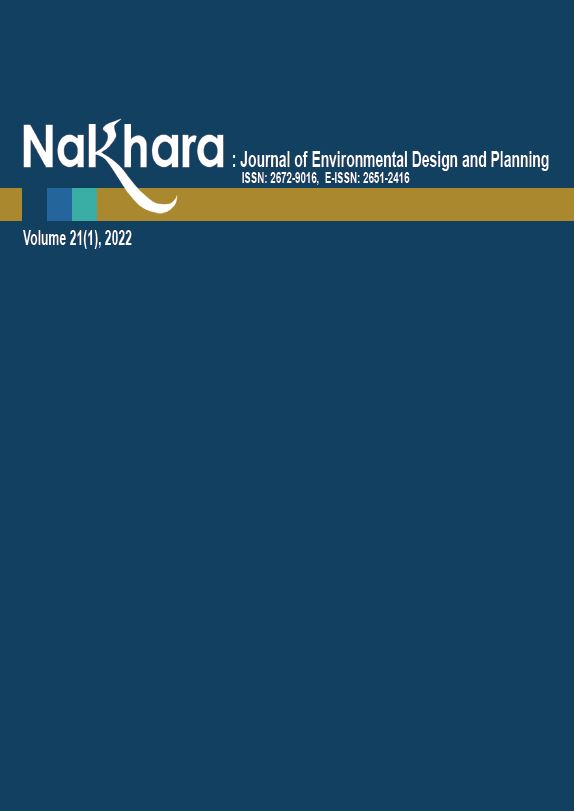Passive and Biophilic Design: Assessment of the Semi-Open Educational Atrium Buildings in the Tropics
Main Article Content
Abstract
The contemporary semi-open educational atrium buildings in Southeast Asia are among the most provocative sustainable buildings in tropical architecture. Since the qualities of natural environments inside atriums promote well-being and academic performance, passive and biophilic design strategies are applied to optimize the thermal and visual performances of the buildings. This research aims to assess four selected case studies in Bangkok in order to discover how the atrium elements affect the qualities of the inside natural environmental conditions, and recommend guidelines for semi-open atrium design. The most important natural environment indices are air temperature, radiation, humidity, airspeed, daylight, green area, view in and view out. The research methodology is as follows: Firstly, assess the natural environmental conditions of the case study atriums on-site during summer. Secondly, analyze the thermal and visual performances of the semi-open atriums. Then, find the linkages between the atrium element designs and the qualities of natural environmental conditions. Lastly, recommend passive and biophilic design guidelines for semi-open atriums. The on-site assessment results indicate that all case study atriums perform well above average, although each case study uncovered both pros and cons. The research results showed that: 1) The amount of heat gain and daylight factor depend mostly on the percentage of roof opening (skylight) and the sizes and proportions of the atriums. 2) Relative humidity inside the buildings is reduced by natural ventilation during the daytime. 3) The most effective air velocity is from cross ventilation. 4) Quality of views depends on the openness of the atrium on the ground floor. 5) Biophilic quality depends mainly on the amount of indoor green area. At the end of the research, design recommendations for semi-open educational atrium buildings in the tropics are provided.
Article Details

This work is licensed under a Creative Commons Attribution-NonCommercial-NoDerivatives 4.0 International License.
References
American Society of Heating, Refrigerating and Air-Conditioning Engineers. (2016). ASHRAE handbook 2016, chapter 22 humidifier: Environmental conditions. Academia. https://www.academia.edu/40862269/ASHRAE_Handbook_2016_HVAC
American Society of Heating, Refrigerating and Air-Conditioning Engineers. (2017). ASHRAE handbook fundamentals 2017 (I-P ed.). ASHRAE.
American Society of Heating, Refrigerating and Air-Conditioning Engineers. (2020). ANSI/ASHRAE standard 55-2020: Thermal environmental conditions for human occupancy. Daoke Baba. https://spider.doc88.com/p-18273030588597.html
Baharvand, M., Mohd Hamdan Ahmad, Safikhani, T., & Sayyed Mohammad Mahdi Mirmomtaz. (2013). Thermal performance of tropical atrium. Environmental and Climate Technologies. 2013(12), 34-40. https://sciendo.com/downloadpdf/journals/rtuect/12/1/article-p34.xm
Baker, N., Fanchiotti, A., & Steemers, K. (2013). Daylighting in architecture: A European reference book. Routledge.
European Committee for Standardization. (2018). European daylight standard: EN 17037, Assessment of daylight in interior spaces: View out. VELUX. https://velcdn.azureedge.net/~/media/marketing/ee/professional/28mai2019%20seminar/veluxen17037tallinn28052019.pdf
Givoni, B. (1998). Climate considerations in building and urban design. John Wiley & Sons.
Green Building Index. (2019). Green building index: GBI assessment criteria for interiors. https://www.greenbuildingindex.org/Files/Resources/GBI%20Tools/GBI%20Interiors%20Tool%20V1.2.pdf
Green Star. (2019). Daylight and views hand calculation guide: Daylit atrium views. New Zealand Green Building Council. https://www.nzgbc.org.nz/Attachment?Action=Download&Attachment_id=2842
Han, K. (2019). Effect of indoor plants on the physical environment with respect to distance and green coverage ratio. SAGE journals: Indoor and Built Environment, 30(9), 1353-1372. https://doi.org/10.1177/1420326X20939595
Hiemstra, J., Vries, S., & Spijker, J. (2019). Greenery and education: The positive effects of greenery in urban environments. Wageningen University & Research. https://library.wur.nl/WebQuery/wurpubs/fulltext/418846
International WELL Building Institute. (2020). WELL standard version 2020: Biophilia II – quantitative, indoor biophilia. https://standard.wellcertified.com/mind/biophilia-ii-quantitative
Kellert, S., Heerwagen, j. & Mador, M. (2013). Biophilic design: The theory, science and practice of bringing buildings to life. John Wiley & Sons.
Lechner, N. (2015). Heating, cooling, lighting sustainable methods for architects (4th ed.). John Wiley & Sons.
Tao, Y., Lau, S., Gou, Z., Zhang, J., & Tablada, A. (2019). An investigation of semi-outdoor learning spaces in the tropics: Spatial settings, thermal environments and user perceptions. SAGE journals: Indoor and Built Environment. 28(10), 1368-1382. https://doi.org/10.1177/1420326X19841115
Thai Green Building Institute. (2021). Thai’s rating of energy and environmental sustainability: For new construction and major renovation. https://tgbi.or.th/news-activities/annoucement/2021/06/09/1370/
Tregenza, P., & Wilson, M. (2011). Daylighting: Architecture and Lighting Design. Routledge.
Urban Redevelopment Authority. (2020). Handbook on gross floor area. https://www.ura.gov.sg/services/download_file.aspx?f=%7B29FD6DD5-305C-4BBC-9D3F-5F6C90972D63%7D
Wu, X., Oldfield, P., & Heath, T. (2020). Spatial openness and student activities in an atrium: A parametric evaluation of a social informal learning environment. Building and Environment. 182, 107141. https://doi.org/10.1016/j.buildenv.2020.107141

